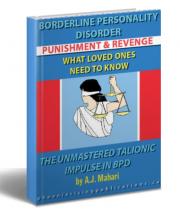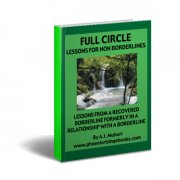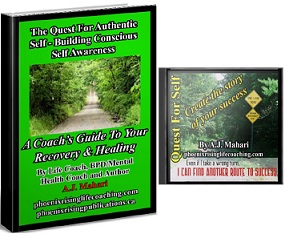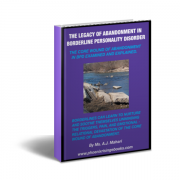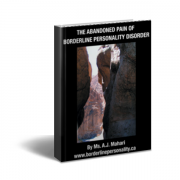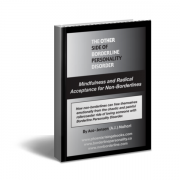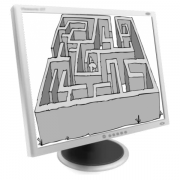Splitting in Borderline Personality Disorder
A.J.'s Audio Program Borderline Splitting - Understanding for Loved Ones
In her book, "Imbroglio" Janice Cauwels writes:
Traumatic Splitting
"Saunders and Arnold, for example, argue that many borderline symptoms are not defenses against intra-psychic conflict, as the psychoanalysts would have it, but rather internalizations of actual experiences of abuse... Within the childhood abuse context, Saunders and Arnold reformulate splitting in terms of its:
TIMING: Although the primitiveness of splitting suggests that it originates in early childhood, Saunders and Arnold argue that it can arise at any point before adolescence due to the devastating impact of chronic abuse within a "safe" family environment.
Purchase all 3 of ebooks for NON BORDERLINES packaged together with or without audio.
Non Borderlines - You can purchase 6 ebooks packaged together with or without audio.
Those with BPD and/or Non Borderlines can purchase A.J. Mahari's 3 "Core Wound of Abandonment" series ebooks packaged together with or without audio.
Audio Programs on BPD for Borderlines and Non Borderlines by A.J. Mahari sold separately or packaged together with Mahari's Ebooks.
RELATIONAL CONTEXT: It is not the mother-child relationship that generates splitting, but rather that between the child and the male perpetrator of abuse. The abuse that results from her ignorance, powerlessness, or neglect in this particular situation is what giver the mother's unresponsiveness to the child its connotation of profound betrayal.
STATUS AS DEFENSE: Splitting is less a defense than a repetition of the child's actual experience of abuse, denial, contradictions, and mixed messages. What Saunders and Arnold call 'a learned template superimposed on contemporary experience' is activated in the borderline when she anticipates a repetition of her early relationships. The extreme reactions that helped the abused child deal with genuine dangers are inappropriate to similar situations in the present and are labeled pathological in the borderline adult...how can a child be expected to picture an abuser realistically, integrate her love for and hatred of him, and develop a stable identity of her own?
A.J.'s Audio Program Borderline Splitting - Understanding for Loved Ones
Splitting can also be explained in terms of another concept discussed by Saunders and Arnold that may apply to borderlines. Traumatic Bonding is the term used by other researchers for the intense, inextricable attachment to someone who alternates loving connection or dependency with intermittent mistreatment. As well as perceiving people as good and bad, the borderline may be attracted to those who genuinely alternate affection and abuse, each of which is then exaggerated in the borderline's mind.
Echoing Dr. Siever's earlier reference to splitting as state dependent, Dr. Herman agrees with the explanation just outlined:
"Why would a child fail to integrate idealized or terrifying images of her caretakers? The reason would have to be either constitutional or adaptive. Splitting is adaptive. Children must preserve some sense of connection at any cost, in this case by walling off the image of the abusive figure from the positive one. I think they do so in a state-dependent way, flipping between modes of affection and terror that accurately reflect their environments. They grow up constantly scanning their interpersonal environments to see if they're safe, reading subtleties of expression, posture, gesture, and so forth in an almost uncanny way. But if you ignore the original reason for this behavior, it looks perverse, incomprehensible, and ultimately pathological."
BIOLOGICAL SPLITTING
Purchase all 3 of ebooks for NON BORDERLINES packaged together with or without audio.
Non Borderlines - You can purchase 6 ebooks packaged together with or without audio.
Those with BPD and/or Non Borderlines can purchase A.J. Mahari's 3 "Core Wound of Abandonment" series ebooks packaged together with or without audio.
Audio Programs on BPD for Borderlines and Non Borderlines by A.J. Mahari sold separately or packaged together with Mahari's Ebooks.
'...splitting may be a kind of specialized state-dependent learning' says Dr. Siever.
Borderlines have highly polarized dissociated states and use dissociation as a defense. When something triggers a positive representation, it may be stored with very good feelings. But the very bad feelings may be so overwhelming and devastating that when those are triggered, they must be kept dissociated. It's not that borderlines cognitively can't recall what another person is really like, but their representations become split off from each other in a sort of state-dependent fashion. The affective immediacy is gone because it doesn't have the same resonance.
Splitting develops a psychological life of its own with borderlines. They can use these idealized images as protection against the negative feelings of rage or helplessness. So they've developed a whole psychological vocabulary.
But in this defense, like others, may evolve or be made more likely from some of the underlying temperamental factors. Someone with an unstable or impulsive temperament is more likely to use splitting as a defense. There's no doubt that abuse and trauma can lend themselves to using dissociation, but some people are nevertheless better at it than others."
A.J.'s Audio Program Borderline Splitting - Understanding for Loved Ones
In the book, "Lost In The Mirror", Dr. Richard Moskovitz describes splitting this way:
"This defensive fiction is called splitting. It is a natural outgrowth of the discontinuity of the infant's experience ..splitting may serve a particularly useful function when a crucial love object, such as a parent, severely violates trust, as occurs with physical or sexual abuse...Splitting enables the child to accept the 'good parents' love without it being tainted by something heinous.
>...If you are borderline, you may never have acquired that basic trust in a loving caretaker. Or, once having learned to trust, you may have been so betrayed that you have had to retreat to a world of discontinuity, peopled by caricatures ...splitting prevents you from developing an enduring image of yourself and others and is partly behind your elusive sense of identity...splitting is a defense intended to protect, but it is also a treacherous force that can destroy relationships and sabotage treatment."
So a child is born to parents who are not healthy or able to care for that child in a loving, nurturing and trustworthy way that is consistent enough for that child to feel safe. When the child feels both safe (sometimes) and unsafe (at other times) splitting is a way to manage the distress of the conflict which is experienced while one is very dependent upon those from whom the conflicting and anxiety- producing feelings stem.
For example, when mother is adequate at care-giving but then as the child gets older mother suddenly abandons the child to the abuse of the father the child feels so betrayed and so unsafe. The ensuing terror causes rage which builds and is often deeply repressed. Being dependent upon the "object" of rage means that the rage cannot be expressed for fear of an engulfed annihilation. In order to continue to cope with mother and to try to have mother meet some very important needs a split occurs. The child then experiences (from one mother) what can be likened to two distinct and separate mothers. The all good and all bad split allows the child to continue to seek what he/she needs from 'good' mother while pushing away from 'bad' mother.
If one experiences this scenario in childhood there will be left over conflicts inside. Until they are worked out often the defense of splitting (in the borderline) will be applied to anyone who either 'takes the place of mother' or anyone who one tries to trust. Many borderlines grow up without experiencing a safe enough environment within which it is healthy and reasonable to extend trust. As one gets older then one does not know how to extend trust. If any trust is extended it usually takes the form of push/pull relating which was learned at a young age from the borderlines inconsistent experience with his/her parents of care-takers. Without the experience of knowing someone to be trustworthy or safe the borderline lacks the ability to recognize safety even where it may exist. Often borderlines grow up without any tangible sense of safety within themselves. This causes them to remain overly-dependent upon others in terms of trying to get their safety needs met.
A.J.'s Audio Program Borderline Splitting - Understanding for Loved Ones
It is the unresolved conflicts and trauma from childhood that the borderline is recapitulating, playing-out and repeating. Whether consciously aware or not there are issues that must be worked through and healed before that "scanning their interpersonal environment to see if they are safe" can be set aside.
The result of this most fundamental damage is BPD itself. Within the emotional carnage of BPD the borderline is unable to see the proverbial 'big picture'. The big picture is reality in between the black and the white of splitting. It is the grey in which both good and bad can exist together. Due to this borderlines either put those they know on 'all good' pedestals or they put people in all bad 'doghouses' depending upon the experience of they have of a given person's 'representation'. Dissociating (through splitting) from the over-all picture of a person and or a situation in and of itself defines the fragmented experience of the borderline.
The walls of this defense and many others grow quite thick. To heal one must have insight into what made the walls which can then lead on to learn how to slowly peel the walls back. The internal conflicts and resultant emotional damage (damage done to the growth and development of personality --and one's ability to relate age appropriately) in childhood must be healed one layer at a time in order for a borderline to be able to stop splitting and to see the good and the bad simultaneously in the big picture of any experience or any person. A big part of this is learning how to experience one's own good and bad qualities and acquiring a working-acceptance of said. This must be achieved before a borderline can tolerate the discrepancies that lie within us all.
A.J.'s Audio Program Borderline Splitting - Understanding for Loved Ones
The healing process with regard to the defense mechanism of splitting is very painful. It involves grieving the trauma that occurred in childhood and that caused the initial splitting. It also involves letting go of what simply does not work in relating to others or to oneself in any stable and healthy manner. Namely, the dependence that is the environment in which splitting is most prevalent. Learning to take personal responsibility and to take care of oneself is the way to unlearn the defense of splitting and is the way to begin to know who you really and truly are consistently, in and through both your weaknesses and your strengths. It is the healthy expression (often in therapy) of the rage that remains from infancy or childhood which can set borderlines free from the ravaging losses and dependency that splitting perpetuate.
Learning to change the way that you think, if you have BPD, is also at the heart of recovery and of leaving the defense mechanism of splitting behind. Splitting in Borderline Personality Disorder has a purpose to serve. It protects those with BPD from pain they are not yet equipped with coping mechanisms for. However, splitting is equally as responsible for keeping those with BPD stuck in the active throes of it if new and brave choices to get professional help and stick with it aren't made. At the heart of so much borderline suffering is the way that those with BPD think. It is the all-or-nothing black-and- white thinking of BPD that is at the heart of splitting and all of the borderline behaviour that it fuels.
Learning to change the way one thinks when one has BPD means being ready to open up to the pain of your core wound of abandonment with a willing attitude to create change through processing the grief and pain that is still very much alive and well for the inner-child of each person with BPD.
© Ms. A.J. Mahari - May 16, 1999 - with additions May 25, 2009
A.J.'s Audio Program Borderline Splitting - Understanding for Loved Ones
A.J. Mahari is currently writing a memoir about her life and experience as a person who had two parents with Borderline Personality Disorder, as a person who was diagnosed herself with BPD at the age of 19 and from her perspective as someone who has recovered from BPD. There is a new section on her BPD Blog called The Diary - My Borderline Years where A.J. Mahari shares snipets of experience from her own life that will give you just a small peak into what her memoir will include.
Audio Program "Preparing For Recovery From BPD" Parts 1 & 2 by A.J. Mahari
Audio Program Rage Addiction in BPD by A.J. Mahari (sold separately or packaged with Mahari's Ebook, "Rage and BPD")
- Purchase all 3 of ebooks for NON BORDERLINES
- Non Borderlines - You can purchase 6 ebooks packaged together with or without audio.
- Those with BPD and/or Non Borderlines can purchase A.J. Mahari's 3 "Core Wound of Abandonment" series ebooks packaged together with or without audio.
No reproduction in whole or in part without the written consent of A.J. Mahari. To seek permission to re-produce anything on this site or to link anything on this site please email me at bpdinsideout@yahoo.ca - I do not give my consent for anything I've written to be re-produced on any other website without my expressed permission. If you wish to link to an article I've written please link directly to the article page on this site - thanks so much!






